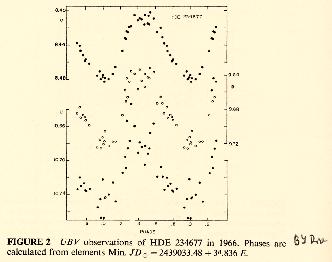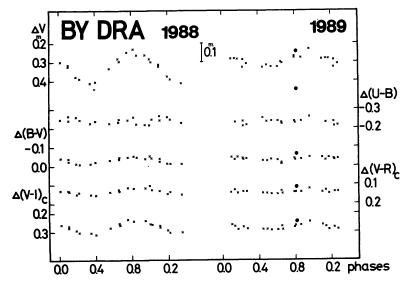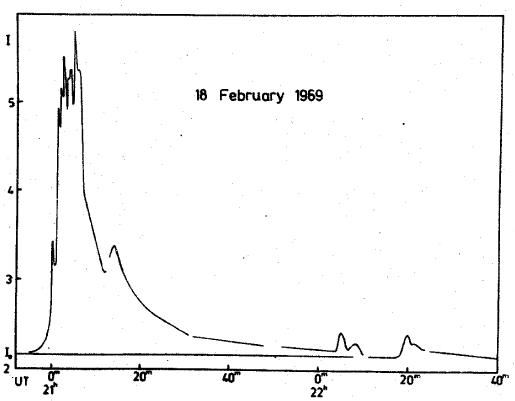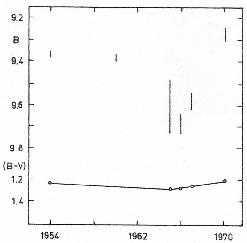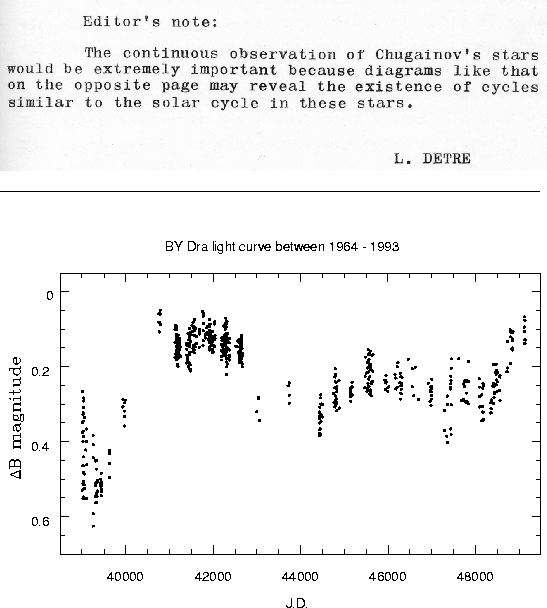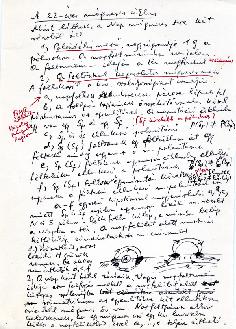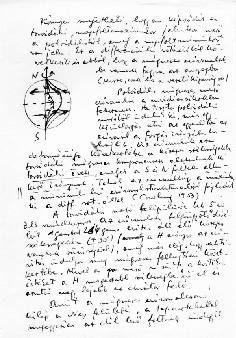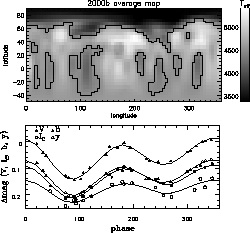Katalin Oláh
Konkoly Observatory of the Hungarian Academy of Sciences
The discovery of starspots has a long history. Curiously, the establishment of the class of active stars is strongly connected with Detre's Institute. The real discovery of starspots (on AR Lac) happened just in the middle of the XXth century by Kron (1947) and soon after on two other objects. But this discovery was forgotten for more than a decade. In 1965 Chugainov (1966) made a series of observations on HDE 234677 (BY Dra) and explained the resulting light curve by starspots. That paper was published in the
In late 1960s and early 1970s, flare stars were increasingly observed. Beside flares, rotational modulations were revealed in several cases. Some stars, like BY Dra showed flares as well as rotational modulation. Fig. fig1 shows a light curve of HDE 234677 observed in 1966 by Krzeminski (1968), which appeared in a conference proceedings on the light variation of dM and dMe stars. At that time the star did not have a variable star designation, but slightly later aroused L. Detre's attention: he marked the name of the variable in the book. This variable was later observed with the 60-cm telescope in Budapest, and in 5 colours (UBVRCIC) with the 1-m telescope at Piszkéstetö mountain station, which is also plotted in Fig. fig1.
Photoelectric monitoring of flare stars were carried out as well in the late 1960s. Among the targets were BY Dra itself and also AD Leo. A huge flare observed in the latter object by Szeidl (1969) is shown in Fig. fig2. These measurements clearly show, that L. Detre was interested in this new type of variable stars. At that time, in lack of clear definition, one could not call them a new class of variables.
From the time of the discovery of starspots it was obvious to relate these features with those observed on the Sun for already centuries. Flares were thought to be huge eruptions on stellar surfaces, just like those detected on the Sun. The search for solar analogues on stars continued and Wilson (1968) initiated a long-term study for searching cycles of solar-type stars through measuring CaII H&K activity, which is continuing to date. But before this, already in 1966, L. Detre published a note of just once sentence, calling the attention on the possible presence of a spot cycle on BY Dra, as shown in Fig. fig3 (upper and middle panels). This small remark was surely among the first ones (if not exactly the first) suggesting cycles on other stars than the Sun.
In the lower part of Fig. fig3 the continuation of the long-term light variability of BY Dra is plotted. Clearly, cycles are present in the overall brightness of this system with quasiperiods of decades, about 14 and 3 years (see Oláh et al. 2000 for the details).
The author had the pleasure to attend L. Detre's classes of astronomy. Those lectures usually dealt with the newest results in variable star astronomy, which were found very useful even long after the graduation. Another topic of his lectures was solar physics, which is strongly connected with the active star research. Figures fig4 and fig5 are examples of L. Detre's handwritten notes for the university lectures on the solar cycle and on the differential rotation.
L. Detre passed away on 1974 autumn. At that time the organization of the IAU Colloquium No. 29,
Thus, the beginnings of stellar activity research is strongly connected with the Konkoly Observatory. It started with the rediscovery of starspots by Chugainov (1966) published in the
Thirty years have passed already, and during all these years stellar activity research has been continuously developing. Simultaneously with the delivery of Hall's (1976) talk studying active stars began at the Konkoly Observatory as well, and the author of this paper, who talked about spotted stars with L. Detre as a student, finally got this subject as a lifetime project from B. Szeidl. It was a unique possibility to take part in a research field from its very beginning. At present, mapping stellar surfaces is a routine task. Figure fig6 shows the surface of an active giant star derived from spectral line profile analysis (Doppler imaging) and the modelled brightness variation from photometric measurements made in four colours by Oláh et al. (2002).
Chugainov, P.F., 1966, Inf. Bull. Var. Stars, 122, 1
(IBVS N°.122)
Chugainov, P.F., 1971, Inf. Bull. Var. Stars, 520, 1
(IBVS N°.520)
Detre, L., 1971, Inf. Bull. Var. Stars, 520, 2
(IBVS N°.520)
Hall, D.S., 1976, in Multiple Periodic Variable Stars, IAU Coll. No. 29, ed. W.S. Fitch, Budapest, Akadémiai Kiadó, 287
(1976mpvs.coll..287H)
Hall, D.S., 1994, IAPPP Comm., No. 54, 1
(1994IAPPP..54....1H)
Kron, G.E., 1947, PASP, 59, 261
(1947PASP...59..261K)
Krzeminski, W., 1968, in Light Variability of dMe and dM stars, Gordon and Breach Science Publishers, ed. S.S. Kumar, p. 56
Oláh, K., Kolláth, Z., Strassmeier, K.G., 2000, A&A, 356, 643
(2000A&A...356..643O)
Oláh, K., Strassmeier, K.G., Weber, M., 2002, A&A, 389, 202
(2002A&A...389..202O)
Pettersen, B.R., Oláh, K., Sandmann, W.H., 1992, A&AS, 96, 497
(1992A&AS...96..497P)
Szeidl, B., 1969, Inf. Bull. Var. Stars, 345, 2
(IBVS N°.345)
Wilson, O.J., 1968, ApJ, 153, 221
(1968ApJ...153..221W)
P.O. Box 67, H-1525 Budapest, Hungary
olah![]() konkoly . hu
konkoly . hu
